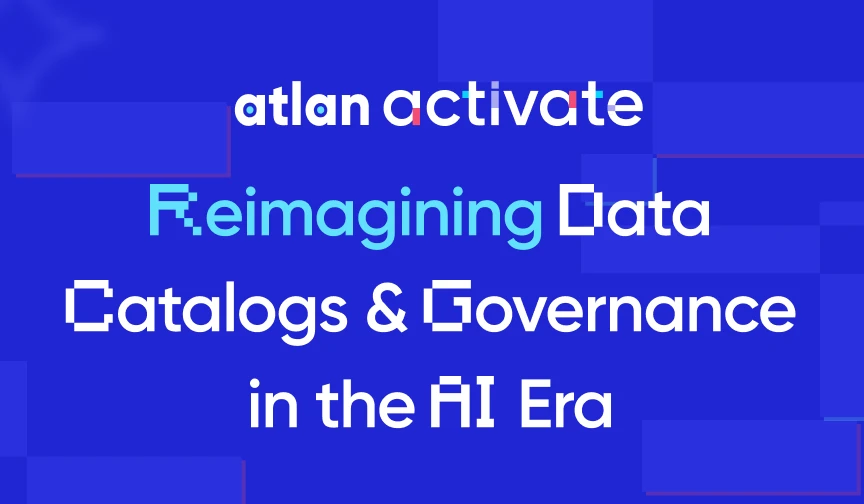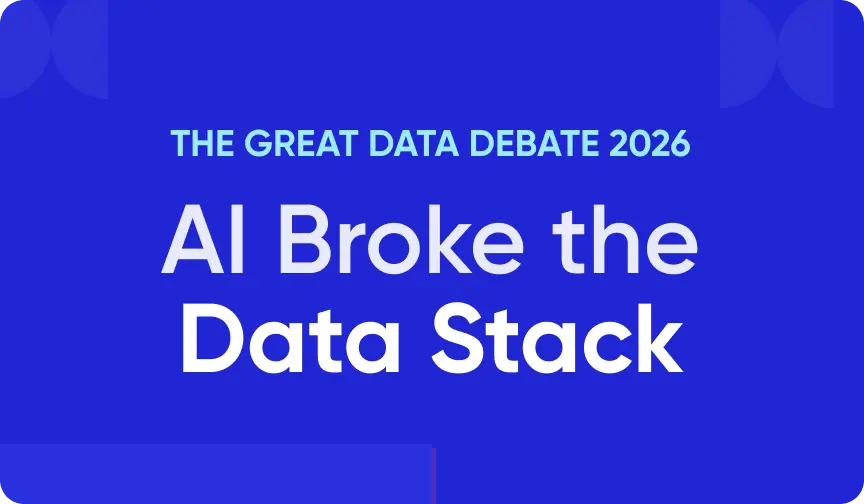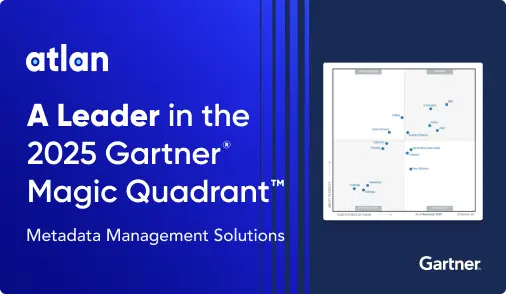Data Quality Solutions: Emerging Trends & Must-Have Product Capabilities in 2025

Last Updated on: June 30th, 2025 | 12 min read
Unlock Your Data's Potential With Atlan

Quick Answer: What are data quality solutions?
Permalink to “Quick Answer: What are data quality solutions?”Data quality solutions are that help organizations ensure their data is accurate, consistent, complete, and reliable for critical business use cases. These solutions help assess, monitor, and improve the fitness of data so that it can be trusted across analytics, reporting, compliance, and AI initiatives.
Without strong data quality controls, organizations risk wasted resources, flawed decision-making, and long-term technical debt. Plus, AI breaks when it runs on bad quality, untrusted data.
Up next, we’ll look at the importance and key capabilities of data quality solutions. We’ll also explore the role of metadata in ensuring data trust, reliability, and use.
Table of contents
Permalink to “Table of contents”- Data quality solutions explained
- What are some of the emerging trends and insights on data quality solutions in 2025?
- What product capabilities should you look for in data quality solutions in 2025?
- Data quality solutions: How Atlan’s Data Quality Studio is built for creating confidence in AI-ready data
- Final thoughts on data quality solutions that build trust in 2025
- Data quality solutions: Frequently asked questions (FAQs)
Data quality solutions explained
Permalink to “Data quality solutions explained”Gartner defines data quality solutions as a “set of processes and technologies for identifying, understanding, preventing, escalating and correcting issues in data that supports effective decision making and governance across all business processes.”
Data quality solutions help organizations evaluate and maintain the health of their data estate. They’re vital for ensuring that your data estate is trustworthy and useful for analytics, compliance, business decision-making, and AI workflows.
Here’s how Melody Chien, Senior Director Analyst, Gartner, distills the business value of quality data that’s fit for purpose:
“Data quality is directly linked to the quality of decision making. Good quality data provides better leads, better understanding of customers and better customer relationships. Data quality is a competitive advantage that D&A leaders need to improve upon continuously.”
Popular use cases for data quality solutions include:
- AI and ML workloads
- Advanced analytics
- Data and analytics governance
- Master data management
- Data engineering
And yet, poor data quality costs organizations an average $12.9 million every year, according to a Gartner study. Poor data quality directly affects revenue and decision-making. Moreover, since AI models are only as good as the data they’re fed, most models fail if the data being used isn’t fit for the specific business question at hand.
What are some of the emerging trends and insights on data quality solutions in 2025?
Permalink to “What are some of the emerging trends and insights on data quality solutions in 2025?”At the 2025 Gartner Data & Analytics Summit, a key theme was the urgent need to move beyond traditional data quality toward AI readiness.
In AI contexts, accuracy and completeness aren’t enough — data must be fit for purpose, meaning aligned to specific business questions, model needs, and risk thresholds. Most conventional data quality metrics remain static and don’t often align quality to business value and specific use cases.
Fitness-for-purpose in data means evaluating whether a data asset meets business-defined expectations for accuracy, freshness, bias sensitivity, and regulatory compliance. This shift demands a rethinking of what’s considered “quality.”
Also, read → How can you ensure data readiness for AI?
Gartner’s Data Quality Maturity Scale provides further guidance for organizations evaluating their data assets:
- Low quality: Basic awareness. Teams define KPIs and quality standards but have limited enforcement.
- Medium quality: Operational focus. Dashboards, quality metrics, and accountability structures are in place.
- High quality: Embedded quality. Data quality is integrated across workflows, from ingestion to AI use cases.
What are some common pitfalls to avoid when evaluating data quality solutions?
Permalink to “What are some common pitfalls to avoid when evaluating data quality solutions?”Data and analytics leaders should recognize that data quality tools aren’t stand-alone products. They support broader initiatives like data integration, master data management, and analytics.
Here are some common pitfalls to avoid when choosing a data quality solution:
- Isolating data quality from governance: Treating data quality as a siloed initiative — separate from cataloging, lineage, and access control — leads to fragmented oversight and inconsistent enforcement.
- Relying solely on traditional metrics: Traditional data quality indicators (like accuracy or completeness) are static and don’t help you evaluate whether data is useful for its intended purpose. So, look for solutions that align data quality efforts to business context and specific use cases relevant to your organization.
- Inadequate enforcement: Without automating rule enforcement across pipelines, quality standards often remain theoretical and not continuous, dynamic workflows across pipelines.
- Neglecting unstructured data: Focusing only on structured tables leaves out critical sources like emails, logs, and documents that may influence downstream AI or compliance outcomes.
- Ignoring metadata as an enabler: Without an active metadata layer, it’s difficult to establish trust signals, trigger automated alerts, or align quality rules with business definitions at scale.
What role does metadata play in ensuring fitness-for-purpose in data?
Permalink to “What role does metadata play in ensuring fitness-for-purpose in data?”Overcoming the above pitfalls and elevating the overall data quality experience requires a stronger metadata foundation. Metadata is the foundation for moving “from just a tech stack to a trust stack”. Without sufficient metadata, you end up with “mis-matching and mis-answering”—precisely the hallucination problems plaguing many early AI implementations.
Also, read → What role does metadata play in enterprise AI workflows?
Gartner’s Magic Quadrant for Augmented Data Quality Solutions reflects this shift by asking for data quality solutions with ‘active metadata support’, which is the ability to ingest, discover, and operationalize metadata from across the ecosystem. This enables capabilities such as:
- Automated lineage to support rapid root-cause analysis and impact assessments.
- Metadata-driven rules that align with business logic, not just technical schema
- Data discovery and cataloging
A metadata-led data quality solution would bridge the gap between infrastructure checks and business-level expectations. With these solutions, you can define, automate, and monitor rules that mirror real-world, business-defined expectations.
Instead of only monitoring pipeline freshness or schema changes, you can define and enforce real-world constraints — like how fresh a fraud detection feature needs to be, or what completeness thresholds a healthcare dashboard must meet.
As GenAI adoption accelerates, adopting a metadata-powered data quality solution, like Atlan’s Data Quality Studio, is essential for maintaining an audit-ready, compliant, and trusted data estate.
So what does modern data quality look like in practice? Let’s explore the key product capabilities that define solutions built for 2025 and beyond.
What product capabilities should you look for in data quality solutions in 2025?
Permalink to “What product capabilities should you look for in data quality solutions in 2025?”Modern data quality solutions must go beyond surface-level profiling and provide deep, contextual, and business-aligned capabilities.
A data quality solution that can adapt to the rapidly evolving AI and data landscape must have these core capabilities:
- Broad data connectivity: Support data across cloud, on-premises, hybrid, and multi-source environments, including relational and nonrelational systems, batch and streaming pipelines, and internal or third-party sources.
- Unstructured data support: Extend data quality checks beyond structured tables to include text, logs, PDFs, emails, and other unstructured formats common in operational and customer-facing workflows.
- Business workflow integration: Built-in workflows for quarantining, assigning, escalating, and resolving data quality issues. Support for role-based task assignment and case management is critical for operational scale.
- Continuous profiling and monitoring: The solution should allow for comprehensive profiling and automated, rule-based monitoring of key metrics. This includes adaptive monitoring rules, alerts for anomalies, and dashboards or logs to meet audit and compliance needs.
- Data quality discovery, management, and enforcement: Support for defining, deploying, and enforcing custom and prebuilt/out-of-the-box rules for schema validation, freshness, completeness, and more. Rules should be traceable, auditable, and linked to business-critical data assets.
- Data lineage: Offer detailed, bidirectional lineage to track where data originated, how it transformed, and how issues propagate. This is key for root cause analysis and regulatory reporting.
- Active metadata support: Leverage real-time, contextual metadata from across the ecosystem to recommend rules, link policies to assets, automate tagging, and guide remediation.
- Matching and linking records: Use of deterministic rules, metadata, or ML-based techniques to identify, merge, or deduplicate related records across disparate systems or datasets.
- Data enrichment and curation: Enrich internal datasets with trusted third-party or external datasets for improving completeness, standardization, or classification.
- Embedded collaboration: Support collaboration within the data quality solution through comment threads, web browser plugins for BI tools, ownership assignment, issue flagging, and more.
- Role-based usability: Ensure the platform is intuitive for both technical and non-technical users, enabling business stakeholders to define rules, investigate issues, and take corrective action without engineering dependencies.
- Alerts, notifications, and visualizations: Real-time alerts for threshold breaches, intuitive dashboards for tracking quality KPIs, and tools for visualizing trends and issue resolution progress.
With these capabilities in mind, let’s look at how one metadata-powered platform — Atlan’s Data Quality Studio — brings them together to support AI-ready data across the stack.
Data quality solutions: How Atlan’s Data Quality Studio is built for creating confidence in AI-ready data
Permalink to “Data quality solutions: How Atlan’s Data Quality Studio is built for creating confidence in AI-ready data”Atlan’s Data Quality Studio keeps bad data out of your business and AI models. It acts as the connective tissue across your stack, helping you integrate with upstream data quality tools, and combine discovery, governance, and quality in a single control plane for one trusted view of data health.
Here’s how Atlan ensures fitness-for-purpose in your data estate:
- Proactive data quality management: Atlan’s Data Quality Studio integrates seamlessly with platforms like Snowflake to unify tests, documentation, issues, and ownership. Instead of reactive checks, teams receive alerts with real-time context on lineage and downstream impact.
- Automated monitoring and anomaly detection: Centralizes and automates checks from upstream tools such as Soda, Monte Carlo, and Great Expectations. Alerts and quality signals are tied directly to specific assets, so teams can quickly triage what broke, where, and who’s responsible.
- Data quality ownership and resolution: Routes quality issues into tools like Slack, Jira, or BI platforms. Tickets are enriched with asset context, lineage, and assigned ownership, making resolution part of daily team workflows.
- No-code rules and smart scheduling: With Atlan’s Data Quality Studio, you can publish tests with point-and-click templates, or power up with custom SQL. Additionally, you can also run checks on a cron, on-demand, or whenever fresh data lands.
- Trust through metadata policies: Uses metadata tags to drive automated policy enforcement. For example, fields flagged as PII can be masked automatically, and access can be restricted based on freshness scores or classification status. So, trust is enforced automatically through lineage, classification, and policy-based controls.
- End-to-end visibility and traceability: Provides granular lineage from column to dashboard. This helps data teams assess the downstream impact of issues for audit readiness and faster root cause analysis.
- AI guardrails: You can pair the Data Quality Studio with Atlan’s AI Governance module to ensure only high-quality data trains and tests your models.
- Data quality at a glance: Track coverage, failures, and business impact in one glanceable Reporting Center acting as a single control plane for checking data health.
- Trust across the business: Through Atlan’s Trust Signals (such as freshness, documentation, popularity, and ownership), data consumers get confidence indicators before using an asset. Meanwhile, data contracts help in formalizing quality expectations to build trust between data producers and consumers.
- Interoperability with broader data stack: Atlan integrates with external metadata stores, technical data catalogs, MDM platforms, BI platforms, ingestion tools and other tools in your data stack. So, you can embed quality workflows across the entire data estate.
Final thoughts on data quality solutions that build trust in 2025
Permalink to “Final thoughts on data quality solutions that build trust in 2025”In 2025, data quality is about readiness, trust, and business alignment. The rise of AI and real-time analytics has made fitness-for-purpose a core requirement for data quality.
Traditional quality checks focused on pipeline health or schema validation fall short in this context. What’s needed is a solution that links quality rules to actual business needs and continuously monitors whether data meets those expectations.
Modern data quality solutions must also account for the complexity of today’s data environments — spanning cloud, on-premises, structured, and unstructured data sources. Capabilities like lineage tracing, real-time alerting, rule-based enforcement, and active metadata support are now essential.
Ultimately, good data quality enables better decision-making, more resilient systems, and fewer costly downstream issues. As data estates grow, the ability to measure, track, and improve data quality in a systematic, scalable way will be a key differentiator for data teams and organizations alike.
Data quality solutions: Frequently asked questions (FAQs)
Permalink to “Data quality solutions: Frequently asked questions (FAQs)”1. What are data quality solutions?
Permalink to “1. What are data quality solutions?”Data quality solutions are tools and processes that help ensure your data is accurate, complete, consistent, and reliable for business use. They typically include profiling, monitoring, rule enforcement, and integration features to help detect and fix issues across your data estate.
2. What should I look for in data quality solutions in 2025?
Permalink to “2. What should I look for in data quality solutions in 2025?”Look for solutions that go beyond basic profiling — support for unstructured data, active metadata, AI-readiness, and business-friendly workflows are now essential. Prioritize tools that integrate well with your stack and allow both technical and business users to collaborate on data quality.
Lastly, look for tools that align with how your teams actually work — not just what looks good in a demo.
3. How do I measure “fitness for purpose” in my data?
Permalink to “3. How do I measure “fitness for purpose” in my data?”“Fitness for purpose” means aligning data quality checks with how the data is used — for instance, ensuring freshness in fraud detection or completeness in customer segmentation. Start by mapping critical use cases and defining success criteria for the data powering them.
4. How do I know if poor data quality is costing us money?
Permalink to “4. How do I know if poor data quality is costing us money?”Look for signs like repeated downstream data fixes, inconsistent reports, or low trust in dashboards. Track the time and cost spent on these issues and correlate them with business impact. Consider running a data quality assessment across a few critical domains to get a clearer picture.
5. How often should we run data quality checks?
Permalink to “5. How often should we run data quality checks?”This depends on the criticality and volatility of your data. For high-impact datasets (like real-time fraud detection), monitor continuously or at ingestion. For batch reporting or dashboards, daily or weekly checks might suffice — but always set thresholds and alerts based on risk.
6. Is metadata really that important for data quality?
Permalink to “6. Is metadata really that important for data quality?”Yes. Metadata provides the context — lineage, classifications, usage history — that powers intelligent quality checks, impact analysis, and automated remediation. Without metadata, you’re relying on manual rules and assumptions, which don’t scale in modern data environments.
Share this article
Atlan is the next-generation platform for data and AI governance. It is a control plane that stitches together a business's disparate data infrastructure, cataloging and enriching data with business context and security.
Data quality solutions: Related reads
Permalink to “Data quality solutions: Related reads”- Data Quality Explained: Causes, Detection, and Fixes
- Data Quality Framework: 9 Key Components & Best Practices for 2025
- Data Quality Measures: Best Practices to Implement
- Data Quality Dimensions: Do They Matter?
- Resolving Data Quality Issues in the Biggest Markets
- Data Quality Problems? 5 Ways to Fix Them
- Data Quality Metrics: Understand How to Monitor the Health of Your Data Estate
- 9 Components to Build the Best Data Quality Framework
- How To Improve Data Quality In 12 Actionable Steps
- Data Integrity vs Data Quality: Nah, They Aren’t Same!
- Gartner Magic Quadrant for Data Quality: Overview, Capabilities, Criteria
- Data Management 101: Four Things Every Human of Data Should Know
- Data Quality Testing: Examples, Techniques & Best Practices in 2025
- Top Takeaways from Gartner D&A Summit 2025: A 5-Minute Recap
- Gartner Magic Quadrant for Data Quality: 2025 Insights
- Data Readiness for AI: 4 Fundamental Factors to Consider
- Role of Metadata Management in Enterprise AI: Why It Matters
- Atlan Launches Data Quality Studio for Snowflake, Becoming the Unified Trust Engine for AI
- Atlan Launches Data Quality Studio for Databricks, Activating Trust for the AI-Native Era





















